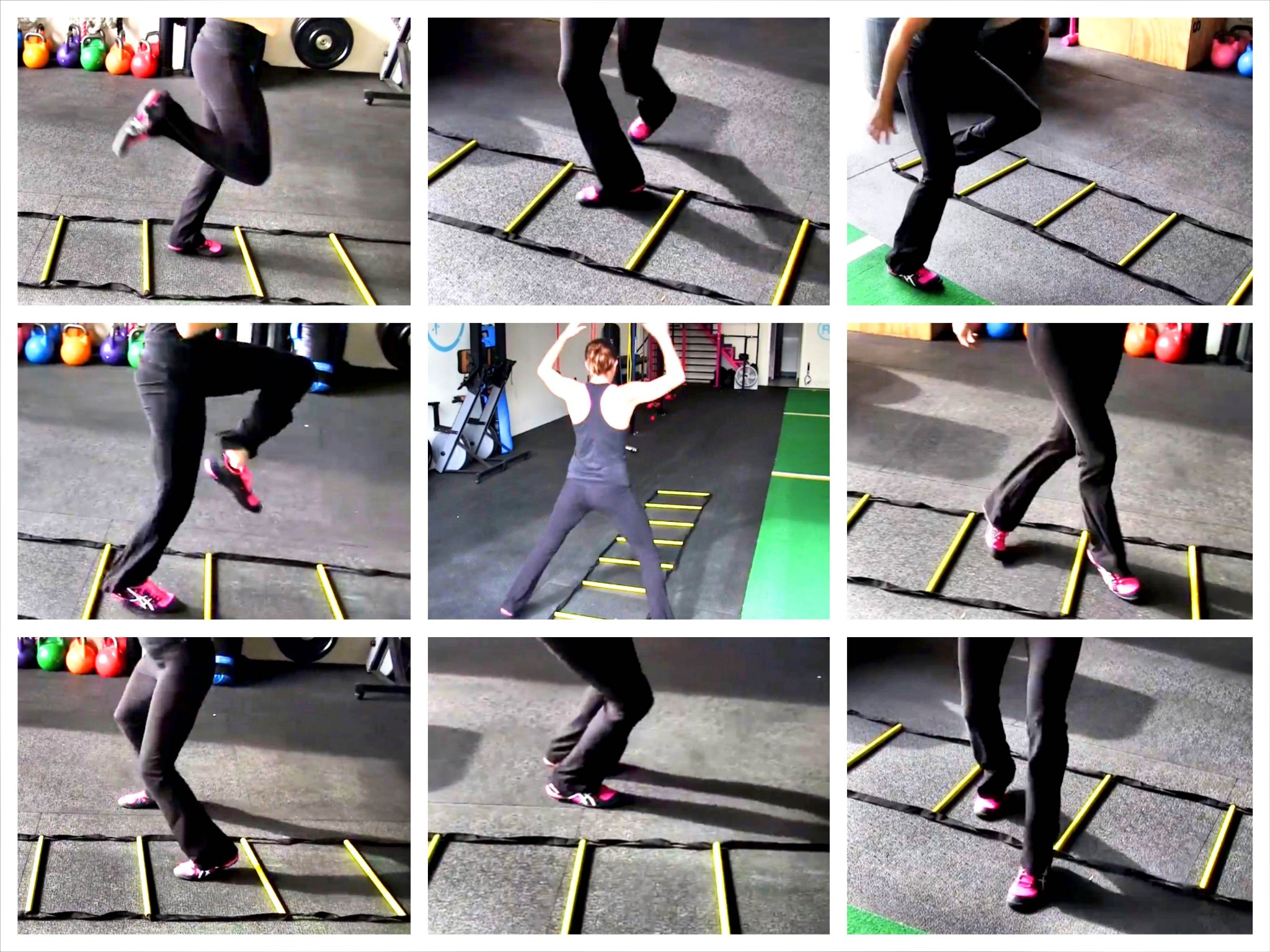To use an agility ladder, lay it flat on the ground and perform various quick feet drills. Agility ladders are versatile training tools that help improve foot speed, agility, coordination, and overall physical performance.
Incorporating agility ladder drills into your workout routine can enhance your athletic ability across various sports and activities. Whether you are a professional athlete, fitness enthusiast, or someone looking to add more variety to their workouts, the agility ladder is a simple yet effective tool to take your training to the next level.
We will explore different ways you can utilize an agility ladder to boost your fitness and skill level.
Selecting The Right Location
Choosing the right location is crucial when it comes to effectively using an agility ladder. The ideal surface, safety considerations, and surrounding environment should all be taken into account. Let’s explore each aspect in detail.
Ideal Surfaces
The choice of surface plays a significant role in the overall success of your agility ladder workout. Look for a flat, non-slippery area that provides ample traction. Here are some ideal surfaces for using your agility ladder:
- Grass: Laying your agility ladder on grass offers a forgiving surface, reducing the risk of injuries caused by slips or falls.
- Rubber Flooring: Gyms or indoor facilities often have rubber flooring, which provides excellent grip and cushioning for your ladder drills.
- Synthetic Turf: If grass is not available, synthetic turf is a suitable alternative, providing a stable and slip-resistant surface.
Remember, the key is to avoid hard or uneven surfaces that may lead to unnecessary strain on your joints and increase the chances of accidents during your training.
Safety Considerations
Prioritizing safety is crucial before embarking on any agility ladder routine. Pay attention to the following safety considerations:
- Clear Space: Ensure you have enough room to perform your ladder drills without any obstructions that might cause tripping or collisions.
- Well-Lit Area: If you’re training outdoors, choose a well-lit area to minimize the risk of missteps due to poor visibility.
- Remove Hazards: Before starting your workout, scan the area for any debris, loose objects, or potential tripping hazards that could interfere with your ladder drills.
- Secure the Ladder: Make sure the agility ladder is properly secured to the ground using stakes or weights to prevent any movement during your session.
- Wear the Right Shoes: Opt for athletic shoes with good traction to improve stability and reduce the risk of slipping.
By following these safety measures, you can create a secure environment that allows you to focus solely on your agility ladder workout, maximizing your performance and minimizing the chance of injuries.

Credit: redefiningstrength.com
Basic Agility Ladder Drills
Agility ladder drills are essential for improving footwork, speed, and agility in various sports.
Ladder Step Exercises
Ladder Step Exercises involve moving through the rungs of the ladder in different patterns.
- Begin with simple forward steps, placing one foot in each square as you move through the ladder.
- Next, try lateral steps, moving side to side across the ladder with quick and precise footwork.
- For fast feet drill, alternate your feet rapidly in each box, maintaining a quick tempo.
Lateral Agility Drills
Lateral Agility Drills focus on improving side-to-side movement and agility.
- Perform lateral hops, jumping side to side over each ladder rung with both feet together.
- Try in-and-out drills, quickly stepping in and out of each ladder square with agility and control.
- For zig-zag shuffle, move laterally through the ladder in a zig-zag pattern, alternating directions.
Advanced Training Techniques
Advanced training techniques with the agility ladder can take your workouts to the next level. Incorporating high-intensity interval training and focusing on precision and footwork enhancement can maximize your agility and overall athletic performance.
High-intensity Interval Training With The Agility Ladder
High-intensity interval training (HIIT) with the agility ladder involves alternating between short bursts of intense exercises and brief rest periods to boost cardiovascular fitness and burn calories effectively.
Precision And Footwork Enhancement
Precision and footwork enhancement drills on the agility ladder can improve coordination, balance, and speed, vital for various sports like soccer and basketball.

Credit: m.youtube.com
Incorporating Agility Ladder Into Workouts
Using an agility ladder is an excellent way to enhance your workout routines. This versatile training tool helps improve agility, speed, coordination, and overall athletic performance. By incorporating the agility ladder into your workouts, you can take your fitness routine to the next level. In this article, we will explore different ways to maximize the benefits of agility ladder training. We’ll focus on warm-up and dynamic stretching exercises, as well as strength and conditioning workouts.
Warm-up And Dynamic Stretching
Before jumping into the intense part of your workout, it’s essential to warm up your body and engage in dynamic stretching exercises. Doing so helps prepare your muscles, joints, and tendons for the upcoming agility ladder drills. Incorporate the following warm-up exercises to optimize your performance:
- Jumping jacks: This classic exercise warms up the entire body, elevates your heart rate, and loosens up your joints.
- High knees: Jog in place while lifting your knees as high as possible with each step. This dynamic movement activates your legs and increases hip flexibility.
- Butt kicks: Similar to high knees, butt kicks involve jogging in place, but this time, aim to kick your buttocks with your heels. This exercise helps warm up the hamstrings and calf muscles.
- Walking lunges: Take large steps forward while bending both knees, lowering your body towards the ground. This exercise activates the quadriceps, glutes, and hips.
By incorporating these warm-up exercises into your routine, you’ll have a better foundation to perform agility ladder drills effectively and reduce the risk of injury.
Strength And Conditioning Workouts
The agility ladder is not limited to warm-ups and stretches; it offers a wide range of strength and conditioning exercises. Integrate the following drills into your workouts to enhance your overall physical fitness:
| Exercise | Description |
|---|---|
| Fast Feet | Stand facing the ladder, and as fast as possible, step into each square while rapidly picking up your feet. |
| Lateral Shuffle | Start at one end of the ladder, then quickly move laterally side to side, stepping into each square. |
| Jumping In and Out | Jump with both feet inside and outside each square of the ladder continuously. |
| Single-Leg Hops | Hop from one square to the next using only one leg, alternating between legs. |
These strength and conditioning exercises provide a challenging workout, targeting different muscle groups while improving agility and coordination. Incorporating them into your routine will have you well on your way to enhanced athletic performance.
Maintenance And Storage
When it comes to maintaining and storing your agility ladder, proper care and storage practices are essential to extend its lifespan and ensure optimal performance. In this section, we’ll discuss how to keep your agility ladder in good condition and the proper storage practices to preserve its functionality and durability.
Keeping The Agility Ladder In Good Condition
Regular maintenance is crucial for keeping your agility ladder in top shape. Ensure that the ladder is free from dirt, debris, and moisture after each use to prevent damage and deterioration.
- Wipe down the ladder with a damp cloth and mild soap, then thoroughly dry it to prevent rust or corrosion.
- Inspect the rungs and straps for any signs of wear and tear, such as fraying or loosening. Replace any damaged components promptly to maintain the ladder’s integrity.
- Store the ladder in a cool, dry place to prevent exposure to excessive heat or humidity, which can degrade the materials over time.
- Perform regular checks for loose or missing screws, and tighten or replace them as needed to uphold the ladder’s stability and safety.
Proper Storage Practices
Implementing proper storage practices is essential for preserving the agility ladder when not in use.
- Roll the ladder up neatly and secure it with Velcro straps or a designated storage bag to prevent kinks or damage to the rungs and straps.
- Store the ladder in a dedicated area, away from heavy equipment or sharp objects that could potentially cause punctures or tears in the material.
- Keep the ladder elevated off the floor to avoid exposure to moisture and potential damage from pests or rodents.
- Label the storage container or area to ensure easy identification and retrieval when needed for future use.
:max_bytes(150000):strip_icc()/young-woman-exercising-on-sports-field-with-agility-ladder-681902083-38c6186ccea047ad8a054ecc3e07f28b.jpg)
Credit: www.verywellfit.com
Frequently Asked Questions For How To Use Agility Ladder
How Can I Benefit From Using An Agility Ladder?
Using an agility ladder can improve your speed, coordination, and agility. It’s also a great way to enhance cardiovascular fitness and overall athleticism. Regular use can help minimize injury risk and enhance performance in sports and daily activities.
What Are Some Basic Drills For Agility Ladder Training?
Basic agility ladder drills include high knees, lateral shuffles, and quick feet. These drills focus on improving speed, footwork, and coordination. They are ideal for athletes seeking to enhance their agility and explosiveness.
Can Agility Ladder Training Improve My Sports Performance?
Yes, agility ladder training can greatly enhance sports performance. It helps in developing better footwork, agility, and quickness, which are essential for various sports such as soccer, basketball, football, and tennis. The improved agility and speed gained through ladder training can give athletes a competitive edge on the field.
Conclusion
To sum it up, incorporating an agility ladder into your fitness routine can elevate your speed, coordination, and overall athleticism. By consistently practicing ladder drills, you’ll notice improvements in your agility, balance, and quickness. Remember to start with simple exercises and gradually progress to more challenging ones.
So, take advantage of this versatile training tool and propel your performance to new heights. Get your agility ladder and start reaping the benefits today!
{ “@context”: “https://schema.org”, “@type”: “FAQPage”, “mainEntity”: [ { “@type”: “Question”, “name”: “How can I benefit from using an agility ladder?”, “acceptedAnswer”: { “@type”: “Answer”, “text”: “Using an agility ladder can improve your speed, coordination, and agility. It’s also a great way to enhance cardiovascular fitness and overall athleticism. Regular use can help minimize injury risk and enhance performance in sports and daily activities.” } } , { “@type”: “Question”, “name”: “What are some basic drills for agility ladder training?”, “acceptedAnswer”: { “@type”: “Answer”, “text”: “Basic agility ladder drills include high knees, lateral shuffles, and quick feet. These drills focus on improving speed, footwork, and coordination. They are ideal for athletes seeking to enhance their agility and explosiveness.” } } , { “@type”: “Question”, “name”: “Can agility ladder training improve my sports performance?”, “acceptedAnswer”: { “@type”: “Answer”, “text”: “Yes, agility ladder training can greatly enhance sports performance. It helps in developing better footwork, agility, and quickness, which are essential for various sports such as soccer, basketball, football, and tennis. The improved agility and speed gained through ladder training can give athletes a competitive edge on the field.” } } ] }
